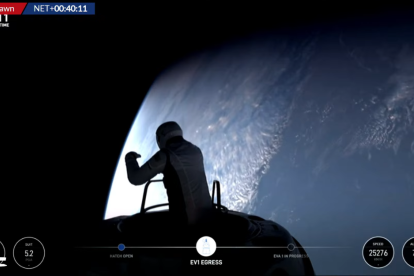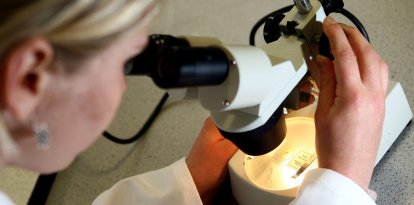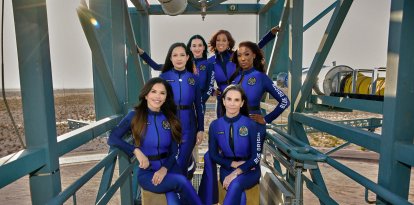SpaceX's 'Polaris Dawn' crew undertakes first private flight spacewalk
Jared Isaacman, CEO of Shift4 Payments, and Sarah Gillis, an engineer at Elon Musk's company, tested innovative suits designed and manufactured by the company itself in outer space.

Jared Isaacman during the space walk
A milestone a day. Polaris Dawn's takeoff marked the first space mision with a civilian crew in history and the next day it reached the farthest orbit from Earth. This Thursday, its crew undertook the first spacewalk on a private flight.
First out of the gate was the one who funded the mission, Jared Isaacman, CEO of Shift4 Payments. SpaceX previewed that Isaacman would be doing some mobility testing, examining the performance of the privately designed spacesuit. He was followed out the exit door by engineer Sarah Gillis.
Veteran Air Force pilot Scott Kidd Poteet and engineer Anna Menon did not exit the cabin, although they were exposed to the vacuum of space until Gillis closed the door upon re-entry (another milestone, SpaceX celebrates: the first time all crewmembers have been exposed to the vacuum of space). Poteet and Menon were in charge of monitoring vital support systems.
After closing the door, the cabin had to be re-pressurized, raising oxygen and nitrogen levels.
The clothing of the future?
The crew members wear two types of suits, both designed by Elon Musk's company: one for those who don't leave the capsule (intravehicular activity) and the other for spacewalking (intravehicular activity).
Testing the suits is one of the crew's main goals, with innovations such as helmets made with 3D printers and polycarbonate visors. They insulate the temperature and protect the eyesight like sunglasses.
In fact, the key moment of the walk is when the suits become the only layer between the crew and space. The only source of oxygen, heat... This clothing is a key part of SpaceX's plan for the Moon and Mars, since, the company says, they are scalable and can be produced in different sizes.
During the spacewalk, the Polaris Dawn crew will wear the new SpaceX EVA suits → https://t.co/LRl5pPlAC9 pic.twitter.com/MVHzNwiWZU
— SpaceX (@SpaceX) September 10, 2024
Far, far away
SpaceX's spacecraft reached 870 miles (1,400 kilometers) on Thursday, surpassing the 853 miles (1,373 kilometers) reached by NASA's Gemini 11 in 1966. Although the Apollo missions traveled farther, they did not undertake an orbit around Earth because their goal was to travel straight to the moon.
"Mission Specialist Sarah Gillis and Mission Specialist and Medical Officer Anna Menon also became the first two women to have traveled this far in space!" SpaceX celebrated on its social media.
For the spacewalk, the spacecraft reduced its altitude to about 435 miles (700 kilometers) above Earth at its apogee (the farthest point from our planet in its orbit).
RECOMMENDATION





















